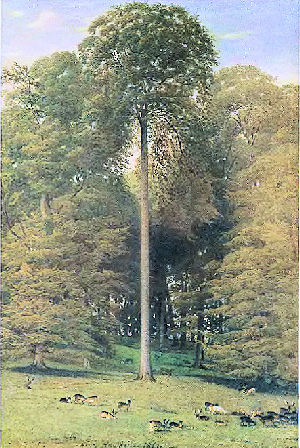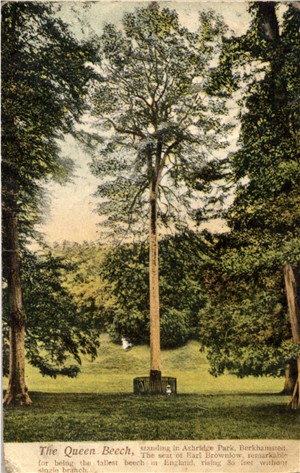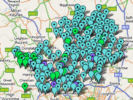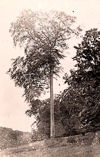
Does anyone know where in Ashridge Park this tree was, and when it was felled?
The following text, and the picture of the Queen's Beech (frontispiece) come from The Trees of Great Britain and Ireland, by Henry John Elwes and Augustine Henry, published Edinburgh, 1906. [Online copy]
At Ashridge Park, Bucks, the property of Earl Brownlow, are perhaps the most beautiful and best grown beeches in all England, not in small numbers, but in thousands. Though the soil is neither deep nor rich, being a sort of flinty clay overlying lime stone, it evidently suits the beech to perfection, and in some parts of the park there is hardly a tree which is not straight, clean, and branchless for 40 to 60 feet, whilst in other parts, where the soil is heavier and wetter, and where oaks grow among the bracken to a great size, the beeches are of a more branching and less erect
The largest and finest beech, from a timber point of view, at Ashridge, known as the King Beech, was blown down about 1891, and was purchased for £36 by Messrs. East of Berkhampstead. Loudon says that this tree in 1844 was 114 feet high, with a clear trunk of 75 feet, which was 5 feet 6 inches in girth at that height. Evidently this was less than its real height. Mr. Josiah East tells me that as it stood it had about 90 feet of clean trunk, of which the lower 15 feet was partly rotten and not measured. The sound part was cut into three lengths as follows :—
| 17 | feet | x | 29 | inches, | ¼ girth | = | 99 | cubic feet | |||
| 18 | " | x | 25 | " | " | = | 136 | " | |||
| 30 | " | x | 23 | " | " | = | 110 | " | |||
| butt, say | 15 | " | x | 36 | " | " | = | 135 | " | ||
| --- | ---- | ||||||||||
| 90 | 480 |
The branches were partly rotten and much broken in falling, so that they were only fit for firewood. But the celebrated Queen Beech remains, and though in one or two places it shows slight signs of decay, it may, I hope, live for a century or more, as it is in a fairly sheltered place, and has no large spreading limbs to be torn off by the wind. This extremely perfect and beautiful tree was photographed with great care from three positions by Mr. Wallis (Plate 3), and as carefully measured by Sir Hugh Beevor and myself in Sept. 1903. We made it as nearly as possible to be 135 feet high (certainly over 130), and this is the greatest height I know any deciduous tree, except the elm, to have attained in Great Britain. Its girth was 12 feet 3 inches, and its bole straight and branchless for about 80 feet, so that its contents must be about 400 feet to the first limb.
Other extraordinary beeches at Ashridge are figured. Plate 4 is an illustration of natural inarching of a very peculiar type : the larger tree is 17 feet 6 inches in girth, the smaller, 4 feet 9 inches, and the connecting branch 12 feet long. It passes into the other tree without any signs to indicate how the inarching took place, and might almost have been a root carried up by the younger tree from the ground, as it has no buds or twigs on it. There are several beeches at Ashridge with very large and curious bosses on the trunk ; one of these (Plate 5) at the base measured 21 feet over the boss, another had a large burr growing out of the side of a straight, clean, healthy tree at 40 feet from the ground. Such burrs are formed on the trunks of healthy as well as of diseased beeches, but I am not sure whether they ever have their origin in injuries produced by insects, birds, or other extraneous causes. Sometimes they have a horny or almost coral-like growth. Such burrs when cut through have an ornamental grain, which might be used for veneers when sufficiently compact and solid, but are left to rot on the ground by timber merchants, who as a rule place no value on such products.
In some parts of this park the beeches show a remarkably wide-spreading network of snake-like roots on the surface, which, though not uncommon in this tree when growing on shallow soil, are here unusually well developed. There is a remarkable beech clump to the east of the house containing 26 trees in a circle of 197 paces (11 of them grow in a circle of 78 paces), of which every tree is large, clean, and straight. The largest of them is about 125, perhaps 130, feet high, and 13 feet 10 inches in girth, and the average contents of the trees probably over 200 feet. I do not think I have ever seen in England such a large quantity of timber on so small an area.
But though it is doubtful whether any place in England can boast so many perfect beech trees as Ashridge, this park contains also some of the finest limes, the largest horse-chestnuts, and the most thriving and bulky chestnuts; and in a wood not far off is an ash which is much the best-grown tree of its species, if not the largest, that I have seen in England. All things considered, I doubt whether there is a more interesting and beautiful type of an English park than Ashridge, for though it contains few exotic trees, and no conifers except some Scotch pines, it has a magnificent herd of red, of Japanese, and of fallow deer, as well as flocks of St. Kilda sheep and of white Angora goats.
 |
The Queen Beech, Ashridge Postcard published by Loosley & Sons and posted in 1919 (also known without text, posted 1909 but 1904 style back, and uncoloured, with c1910 back and with identical descriptive text at the top of message space) The Queen Beech standing in Ashridge Park, Berkhamsted, the seat of Earl Brownlow, remarkable for being the tallest beech in England rising 80 feet without a single branch.
|
|
Other large Beech Trees at Ashridge
The Beeches Ashridge Park Berkhamsted by Hartmann No 4139-5
|
 |
| November 2009 | Page created | |
| May 2014 | Hartmann pc added |



